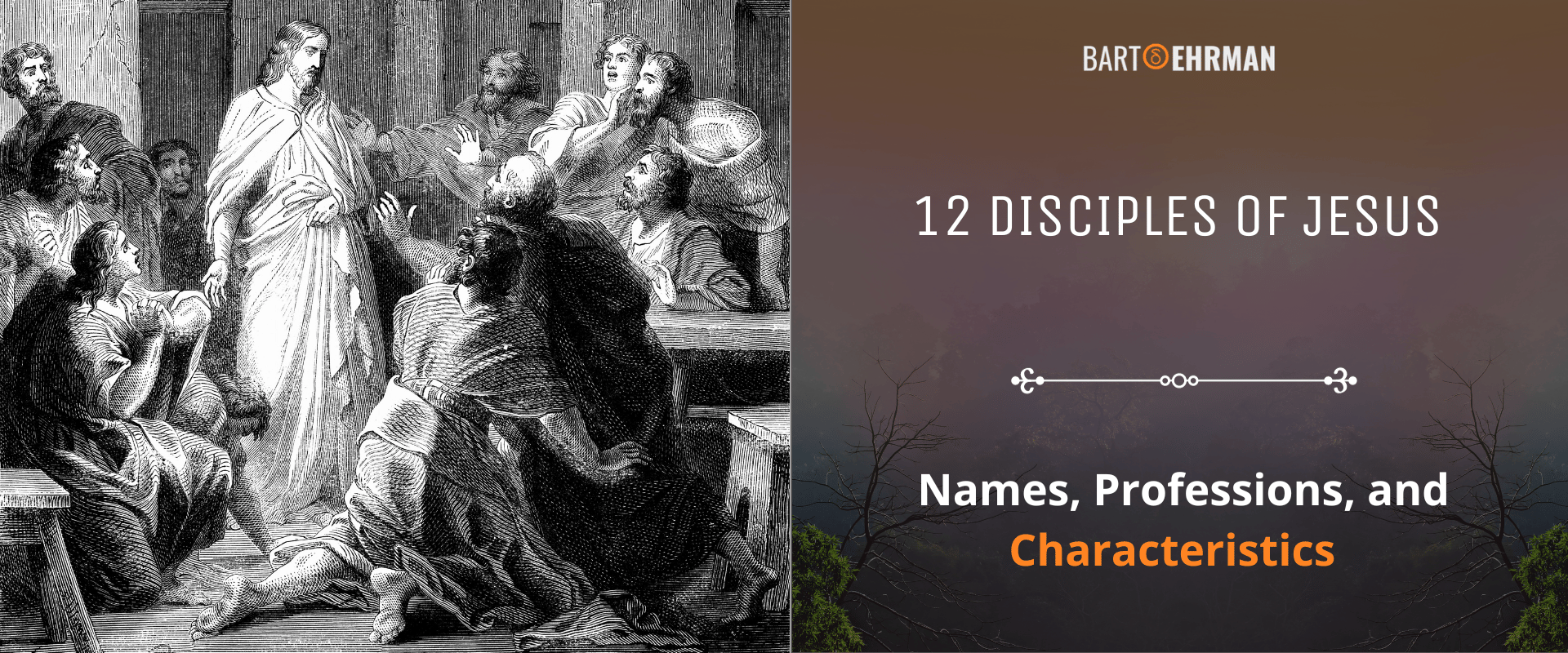12 Disciples of Jesus - Names, Professions, and Characteristics

Written by Joshua Schachterle, Ph.D
Author | Professor | Scholar
Author | Professor | BE Contributor
Verified! See our editorial guidelines
Verified! See our guidelines
Date written: November 28th, 2023
Disclaimer: The views and opinions expressed in this article belong to the author and do not necessarily match my own. - Dr. Bart D. Ehrman
Who were the 12 disciples of Jesus? What is a disciple? While the New Testament refers frequently to Jesus’ disciples, most of us don’t know where the term came from or what it really meant in the ancient world. I’ll define this term in its original context and talk a bit about who Jesus’ twelve disciples really were.

First Things First: Definition of Disciple
The term disciple has become so common after two thousand years of Christian history that many never think about what it actually meant in Jesus’ time. So where does this term originally come from?
The entire New Testament was written in Greek. The biblical Greek word we translate into English as “disciple,” is mathetes (our word “disciple” comes from the Latin equivalent discipulus). These days, many consider a disciple a follower of any charismatic leader. However, when we look at how the word was used before the New Testament, another translation comes to mind: student.
In ancient Greece, a mathetes was the student of a philosopher. Famous Greek philosophers such as Plato and Aristotle had disciples, students who learned philosophy from them. Frederick William Danker notes that the word meant "one who engages in learning through instruction from another, pupil, an apprentice." There was a bit more to it, though.
The Roman philosopher Seneca, a contemporary of Jesus and his disciples, had this to say about Cleanthes, a disciple of the well-known Stoic philosopher Zeno:
Cleanthes could not have been the express image of Zeno, if he had merely heard his lectures; he also shared in his life, saw into his hidden purposes, and watched him to see whether he lived according to his own rules. Plato, Aristotle, and the whole throng of sages who were destined to go each his different way, derived more benefit from the character than from the words of Socrates.
Pierre Hadot writes that a disciple was not simply someone who listened to lectures or read the writings of a philosopher. He lived day to day with the teacher, following his example and, in some ways, actually trying to become a living reflection of that teacher.
This makes sense with the 12 disciples of Jesus. It’s clear from the stories in the New Testament that they were with him day in and day out, learning from him but probably also attempting to imitate his way of life.
Disciple vs. Apostle
One more thing: what is an apostle? Since the disciples are also called apostles in the New Testament, let me briefly define apostle. The Greek word is apostolos, which means “one who is sent, a messenger.” This makes sense because Jesus does send them out to preach to others.
In Luke 10, mention is made of 70 apostles whom Jesus sends out to preach. In this case, the others were likely followers of Jesus while the twelve disciples/apostles were Jesus’ inner circle. Paul, who never met the earthly Jesus, is thus never called a disciple. He considers himself an apostle, having been sent to preach to Gentiles by the resurrected Jesus.
Who Were Jesus’ 12 Disciples?
As usual, the Synoptic Gospels largely agree with each other about the identity of the 12 disciples Jesus called during his lifetime. The Gospel of John, however, while it never makes a clear list like the other Gospels, mentions some different names. Take a look at the chart below.
The 12 Disciples of Jesus' Names in Each Gospel:
Gospel of Matthew | Gospel of Mark | Gospel of Luke | Gospel of John |
|---|---|---|---|
Simon Peter | Simon Peter | Simon Peter | Simon Peter |
Andrew, Peter’s brother | Andrew | Andrew, Peter's brother | Andrew, Peter's brother |
James, son of Zebedee | James, son of Zebedee | James | James |
John, James' brother | John, brother of James | John | John, possibly the “disciple whom Jesus loved.” |
Philip | Philip | Philip | Philip |
Bartholomew | Bartholomew | Bartholomew | Nathanael (traditionally thought to be the same person as Bartholomew) |
Thomas | Thomas | Thomas | Thomas, also called Didymus |
Matthew, the tax collector | Matthew / Levi | Matthew / Levi | not mentioned |
James, son of Alphaeus | James, son of Alphaeus | James, son of Alphaeus | not mentioned |
Thaddaeus (or Lebbaeus) | Thaddaeus | Judas, son of James | Judas (not Iscariot) |
Simon the Canaanite | Simon the Cananaean | Simon the Zealot | not mentioned |
Judas Iscariot | Judas Iscariot | Judas Iscariot | Judas son of Simon Iscariot |
As you can see, the disciples' names common to all four Gospels are Simon Peter, Andrew, James and John, Philip, Bartholomew, Thomas, and Judas Iscariot. The rest are mentioned in some Gospels but not all of them. Let’s explore what we know about these biblical figures.
What Did the Disciples Do for a Living?
The first disciples Jesus calls in the Synoptic Gospels are a pair of brothers, Peter and Andrew, along with two other brothers, James and John. These four presumably knew each other since they were all fisherman in Galilee. According to all the Gospels, all four abandoned their professions and probably their families to follow Jesus.
Another disciple, sometimes called Matthew and other times called Levi, is said to have been a tax collector. This was considered a sinful profession by most Jews since he was collecting taxes for the hated Romans. When Jesus calls Matthew/Levi, he abandons this profession.
The other disciples' professions aren't as clear, but we can make some guesses based on clues in the Gospels.
Philip, like the first four disciples, was from the town of Bethsaida in Galilee, suggesting a possible connection to the fishing trade, although this is not explicitly mentioned. Another disciple, Thomas, also known as Didymus, remains an enigmatic figure with no clear profession stated in the Gospels. However, he is said to have been a carpenter in the Acts of Thomas, a 3rd-century apocyrphal text, although this it quite a late claim to be of much use from a historical standpoint.
Simon the Zealot's title suggests a political affiliation with the Zealots, a group known for their radical opposition to Roman rule, rather than a specific occupation.
Lastly, Judas Iscariot, who would become infamous for his betrayal of Jesus, is thought to have been in charge of the group's money, as mentioned in the Gospel of John, (John 12:6; 13:29) implying a role that required financial acumen. The case is particularly compelling since we know Matthew's profession (again, he was a tax collector) involved stewardship over money. It seems odd that Judas would have been chosen as the group's treasurer - or "keeper of the common purse" - unless Judas' profession uniquely qualified him to be the better choice. Of course, we are speculating here but it's fun to do so!
Scholarly Insights: The Enigma of "The Twelve"
In I Cor. 15:5, Paul says that after Jesus was raised, he appeared to Peter and then to "The Twelve." This presents a fascinating anomaly since Judas would have been absent. Shouldn't Paul have said that Jesus appeared to "the eleven?" This discrepancy has led scholars to propose that by the time Paul was writing to the Corinthians, "The Twelve" had become a titular designation in Chrisitan tradition. The title may have transcended the literal count, instead embodying the group's original number, much like the Big 10 conference in college paradoxically includes fourteen teams but is still known as the Big 10.
Was There a Hierarchy Among the Disciples?
While the twelve disciples were all chosen by Jesus, he seems to have given three of the twelve a special status.
In the Gospels, Peter, James, and John become Jesus’ inner circle among the disciples, sharing knowledge and experiences with Jesus that the other disciples don’t have. They are even referred to as the Pillars of the Church in Paul’s letters. These three are the only ones present at Jesus’ Transfiguration and are with Jesus in the Garden of Gethsemane before his arrest.
To show the special closeness he had with these three, the Gospels say that Jesus gives them nicknames. He calls Peter Cephas, which means “rock” in Aramaic. All four Gospels translate this into the Greek word Petros. Matthew 16:18 says this is because Peter is the “rock” upon which Jesus will build his church. The Gospels also tell us that Jesus called James and John “sons of thunder,” although they don’t say why.
Who Were the Other Disciples?
In Mark, our earliest written Gospel, most of the 12 disciples are chosen by Jesus from a number of other followers. Matthew and Luke, using Mark as a source, tell much the same story, although Matthew/Levi the tax collector is called separately.
In John, Jesus calls Philip who then calls his brother Nathanael whose name is not mentioned in the Synoptics but is traditionally associated with Bartholomew. Despite giving us the names of these other disciples, the Gospels say little else about them.
Our earliest written reference to the 12 disciples appears in one of Paul’s letters, 1 Corinthians 15:3-5:
3 For I handed on to you as of first importance what I in turn had received: that Christ died for our sins in accordance with the scriptures 4 and that he was buried and that he was raised on the third day in accordance with the scriptures 5 and that he appeared to Cephas, then to the twelve.
This indicates that Paul and the early Church believed that Jesus had a special relationship with Peter who saw the resurrected Jesus first. This was apparently followed by Jesus’ appearance to the 12, although Paul doesn’t name the others in this reference.
What About Judas Iscariot?
While Judas Iscariot is mentioned in all four Gospels, he is one of the disciples for whom scholars have the least historical information. In 2 Corinthians 11:23-24, Paul writes of the night Jesus was “handed over,” which could indicate that he was betrayed. However, it seems strange that Paul would leave out the name of the betrayer if he knew it. It is possible that Judas Iscariot was a literary invention.
On the other hand, Bart Ehrman feels that Judas probably did exist, was a follower of Jesus, and did betray him. He says that since the story is attested in multiple sources, it is likely based on fact.

How Did the 12 Disciples of Jesus Die?
Tradition says that all the disciples besides Judas Iscariot were martyred for their faith. This article talks about the martyrdom of Peter, which probably happened during Nero’s persecution of Christians in Rome. The only martyrdom of one of the original disciples described in the New Testament is that of James, son of Zebedee in Acts 12:1-2:
About that time King Herod laid violent hands upon some who belonged to the church. 2 He had James, the brother of John, killed with the sword.
Judas Iscariot, on the other hand, commits suicide out of guilt for betraying Jesus. In the book of Acts, after Jesus’ resurrection and ascension, the remaining eleven disciples draw lots to see which of the other people in their community will replace Judas. The lot falls to a Jesus-follower named Matthias who becomes the 12th disciple.
Conclusion: Who Were the Twelve Disciples of Jesus?
What is the definition of disciple? In the ancient world, a disciple was a student and imitator of a philosopher or teacher. While the disciple was certainly expected to learn the teachings of the master, he was also expected to learn to live like him, which we can see in the relationship between Jesus and his disciples in the Gospels.
Who were Jesus’ Disciples? All four Gospels mention the names Peter, Andrew, James, John, Philip, Bartholomew/Nathanael, Thomas, and Judas Iscariot as the disciples. Other figures, like Matthew/Levi, are not mentioned in all the Gospels.
What were the professions of the disciples? Peter, Andrew, James, and John were initially fishermen. Matthew/Levi was a tax collector. We know far less about the others.
How did the 12 disciples of Jesus die? According to tradition, 11 of the disciples were martyred, although only James’ death is mentioned in the New Testament. Judas Iscariot is said to have died by his own hand out of shame for having betrayed Jesus.

